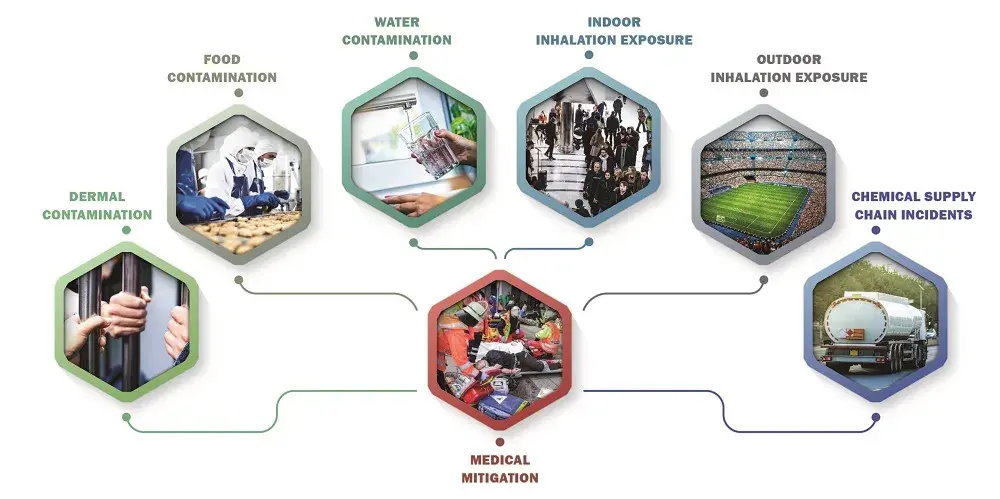Is the U.S. ready for a chemical attack on the homeland? With the very real possibility of a chemical attack in public spaces like stadiums, religious buildings, museums and theaters, or even contamination of the food or water supply, the U.S. needs to be prepared to take appropriate action to save lives. This means having security measures in place to prevent or minimize the attack. It also means having effective medical responses that consider the quantity of medical supplies needed, transportation of those supplies to the scene, and medical facilities and personnel to care for the injured.
 That is why the Department of Homeland Security (DHS) Science and Technology Directorate (S&T) has developed a suite of models at S&T’s Chemical Security Analysis Center (CSAC). These models help federal agencies analyze threats, vulnerabilities and consequences of potential attacks to prioritize resources for the most effective defense and response.
That is why the Department of Homeland Security (DHS) Science and Technology Directorate (S&T) has developed a suite of models at S&T’s Chemical Security Analysis Center (CSAC). These models help federal agencies analyze threats, vulnerabilities and consequences of potential attacks to prioritize resources for the most effective defense and response.
The Chemical Consequence and Threat (CCAT) Tool, part of S&T’s All-hazards Countermeasure Assessment and Planning Tool (CAPT WEB), can rapidly calculate the number of people who would be killed or injured from a chemical release, the factors that might make the release catastrophic, and the current ability to respond to such an emergency. The CCAT Tool, which has a library of 184 chemicals and 37 representative targets, allows users to quickly evaluate the severity of an event and the impact of various response and mitigation strategies. The approach captures the inherent uncertainty of these events by randomly sampling values of key parameters, such as weather conditions, chemical mass used, population density, evacuation times, and calculating the result many thousands of times. These results ultimately highlight opportunities for investment to make the defense of the nation more robust.
Background
The Homeland Security Presidential Directive-22, which is currently being updated, requires analysis of chemical terrorism as a critical element of the nation’s domestic chemical defense policy.
“To support this analysis, CSAC’s Chemical Hazard Characterization Program allows DHS to understand what is happening with chemical events around the world, what we need to plan for now domestically, what we may need to plan for in the future, and what actions have the largest effect on our ability to prevent or respond to an attack,” said Rachel Gooding, Senior Research Scientist at CSAC.
In 2012, CSAC started developing a desktop tool that could rapidly calculate the expected consequences from a chemical release and the impact of the response. The input data, which characterizes the hazard, targets and the public health response, is included in the models as default values or distributions providing a fast and flexible platform for users. Typically, 10,000 calculations are performed in two to three minutes to provide the user with a range of possible outcomes, including the best case, worst case and most likely outcome.
How does CCAT work?
CCAT is a planning tool that consists of six different consequence models, which cover different types of targets. The tool calculates the number of people who are expected to receive a life-threatening, severe or moderate injury based on the concentration and toxicity of the chemical, how long they were exposed, as well as emergency responses including sheltering in place, evacuations or food recalls. Additionally, a medical mitigation model characterizes the current ability to respond and treat people considering available resources, number of people impacted and, and how quickly medical intervention is needed. The analysis helps users evaluate the potential severity of an event and the impact of various response and mitigation strategies, such as more, better or faster countermeasures or the impact of detection or evacuation, and even the impact of others affected on the ability to effectively respond to a large- scale chemical event.
As it only takes milliseconds to run a single simulation, analysts can rapidly identify sensitive parameters and choke points, and can explore the boundaries of what is possible in a response.
Transition and future plans
CSAC has transitioned the software to several U.S. partners and is currently working to transition the capability to a U.K. partner. Current and future U.S. partners include the Johns Hopkins Advanced Physics Lab (which has been using CCAT to support work for DHS), Department of Defense, Combatting Terrorism Technical Support Office, and more. The tool has already been used by the Transportation Security Administration to provide mission support on aviation security, by the Chemical Facility Anti-Terrorism Standards program to assess theft and diversion scenarios, by the food industry to identify and protect vulnerable contamination points and by international partners to analyze the impact of stockpile management strategies and to provide pre-event analysis for special events.
CCAT is one of four characterization tools included in the CAPT Web Suite, which cover biological, radiological and nuclear hazards, in addition to chemical threats. A similar platform to analyze explosive threats is in development and could be ready in late 2020.
“Tools like CCAT provide a systematic and analytical way of prioritizing what we should protect against, how we can best protect against it, what hazards need to be better characterized through experimental work, and where the smartest investments are,” said Gooding. “This is a way of making sure federal dollars are spent the wisest way possible to understand and defend against the most consequential threats we are facing. Ultimately, that is why we are doing it – to save lives.”
For more information, please email csacinfo@ST.dhs.gov.
